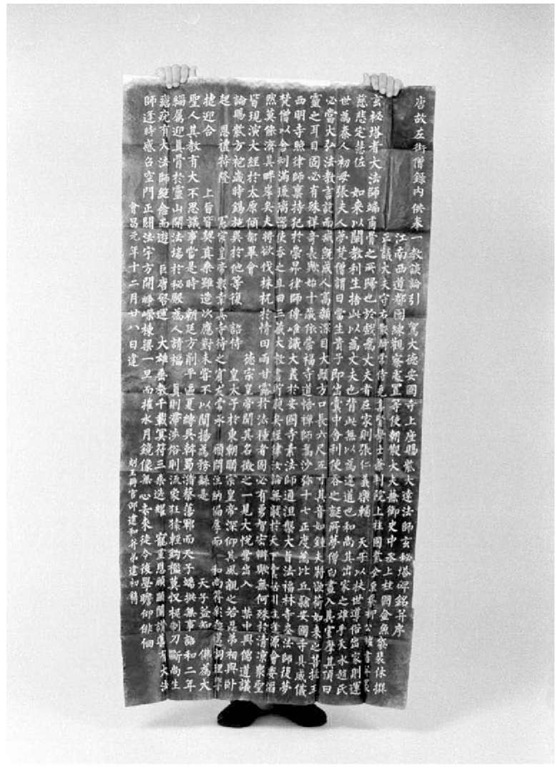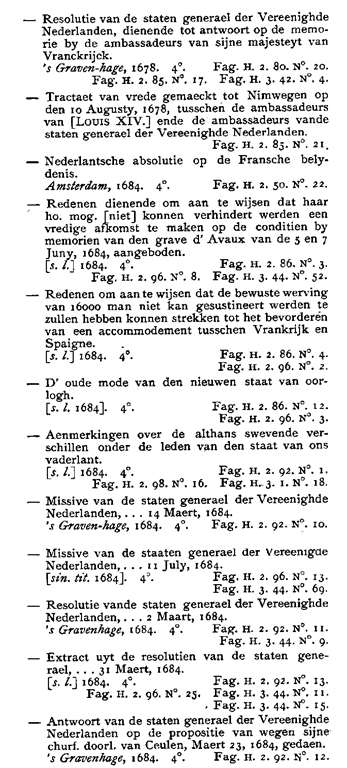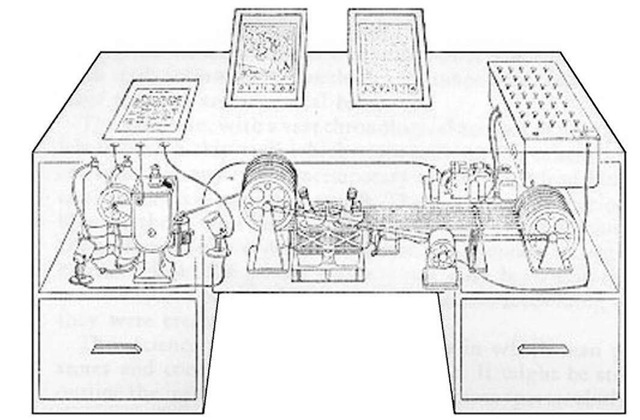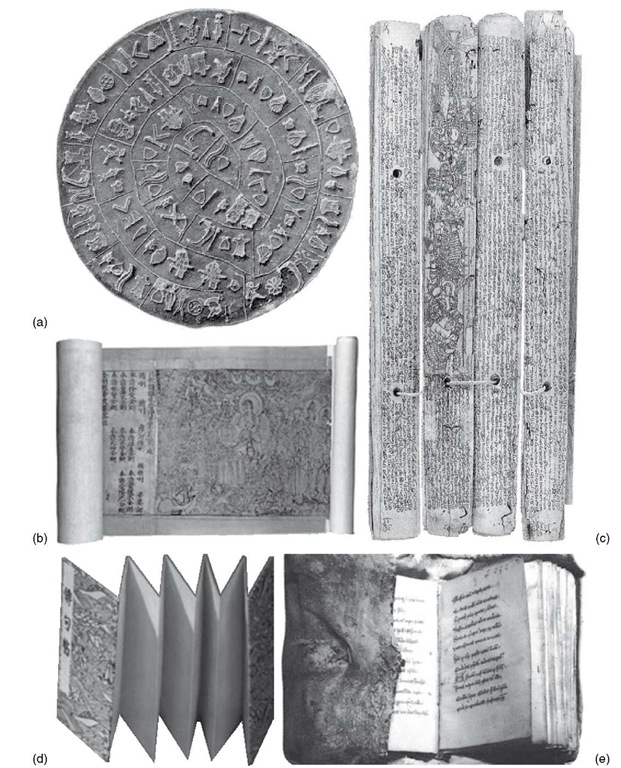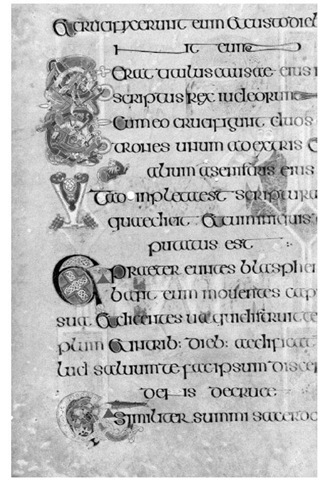Libraries are society’s repositories for knowledge: temples, if you like, of culture and wisdom. Born in an era when agriculture was humankind’s greatest preoccupation, libraries experienced a resurgence with the invention of printing in the Renaissance, and really began to flourish when the industrial revolution prompted a series of inventions that mechanized the printing process—the steam press, for example.
Libraries have been around for more than 25 centuries, although only one individual library has survived more than 5 centuries, and most are far younger. The exception is a collection of more than 2,000 engraved stone slabs, or steles, situated in Xi’an, an ancient walled city in central China with a long and distinguished history. The collection was established in the Song dynasty (ca. 1100 A.D.) and has been gradually expanded with new work since that time. Each stele stands 2 or 3 meters high and is engraved with a poem, story, or historical record (Figure 1.4). For example, Confucius’s works are here, as is much classic poetry, and an account of how a Christian sect spread eastward to China along the Silk Road. Chinese writing is an art form, and this library gathers together the works of many outstanding calligraphers over a period of two millennia. It also contains the heaviest books in the world.
Figure 1.4: Rubbing from a stele in Xi’an
We think of the library as the epitome of a stable, solid, unchanging institution, and indeed the silent looming presence of 2,000 enormous stone slabs (often called the "forest of steles") certainly projects a sense of permanence. But this is an exception. Over the years, libraries have continuously evolved. Originally intended for storage and preservation, libraries have refocused to place users at the center, with increased emphasis on information exchange.
Ancient libraries were useful to only the small minority of people who could read, and they were accessible within stringent limitations imposed by social conditions. Medieval monastic and university libraries held chained copies of books in public reading areas. Other copies were available for loan, although substantial security was demanded for each volume borrowed.
The public library movement took hold in the 19th century. Still, the libraries of the day had book-stacks that were closed to the public: patrons perused the catalog and chose their books, which were then handed out over the counter. In continental Europe, most libraries still operate this way. However, progressive 20th-century librarians came to realize the advantage of allowing readers to browse among the shelves and to make their own selections, and the idea of open-access libraries became widely adopted in English-speaking countries, marking the fulfillment of the principle of free access to the contents of libraries by all—the symbolic snapping of the links of the chained book.
Today we stand on the threshold of the digital library. The information revolution not only supplies the technological horsepower that drives digital libraries, but fuels an unprecedented demand for storing, organizing, and accessing information—a demand that, for better or worse, is economically driven, rather than curiosity-driven as in days gone by. If information is the currency of the knowledge economy, digital libraries will be the banks where it is invested. Indeed, Goethe once said that visiting a library was like entering the presence of great wealth that was silently paying untold dividends.
In the beginning
The fabled library of Alexandria is widely recognized as the world’s first great library—although long before it, Assyrian king Assurbanipal (668-626 B.C.) established a comprehensive, well-organized collection of tens of thousands of clay tablets; and long before that, Chinese written records began, having a history extending at least as far back as the 18th century B.C. Created around 300 B.C., the Alexandrian library grew at a phenomenal rate and, according to legend, contained some 200,000 volumes within 10 years.
The work of the acquisitions department was rather more dramatic than in the libraries of today. During a famine, for example, the king refused to sell grain to the Athenians unless he received in pledge the original manuscripts of some leading authors. The manuscripts were diligently copied and the copies returned to the owners, while the originals went into the library. By far the largest single acquisition occurred when Mark Antony stole the rival library of Pergamum and gave it lock, stock, and barrel (200,000 volumes) to Cleopatra as a love token; she passed it over to Alexandria for safekeeping. These acquisitions increased the collection to 700,000 volumes. More than 2,000 years would pass before any other library would attain this size, notwithstanding technological innovations such as the printing press.
Tragically, the Alexandrian library was destroyed. Julius Caesar set fire to the ships in the harbor of Alexandria in 47 B.C. and the fire spread to the shore. Much of the library survived this, but it was willfully laid waste (according to the Moslems) by Christians in 391 A.D. or (according to the Christians) by Moslems in 641 A.D. In the Arab conquest, Amru, the captain of Caliph Omar’s army, would apparently have been willing to spare the library, but the fanatical Omar is said to have disposed of the problem of information explosion with the immortal words, "If these writings of the Greeks agree with the Koran, they are useless and need not be preserved; if they disagree, they are pernicious and ought to be destroyed."
The information explosion
Moving ahead a thousand years, let us peek at what was happening in a library at a major university near the center of European civilization a century or two after Gutenberg’s introduction of the movable-type printing press around 1450. (The printing press was invented in China much earlier, around five centuries before Gutenberg.) Trinity College, Dublin, one of the oldest universities in Western Europe, was founded in 1592 by Queen Elizabeth I. In 1600 the library contained a meager collection of 30 printed books and 10 handwritten manuscripts. This grew rapidly, by several thousand, when two Trinity College Fellows mounted a shopping expedition to England, and by a further 10,000 when the library received the personal collection of Archbishop Ussher, a renowned Irish man of letters, on his death in 1661.
At the time, however, even this collection was dwarfed by that of Duke August of Wolfenbuttel, Germany, whose collection had reached 135,000 imprints by his death in 1666 and was the largest contemporary library in Europe, acclaimed as the eighth wonder of the world. These imprints were purchased in quires (i.e., unbound) and shipped to the duke in barrels. The duke had them bound in 31,000 volumes with pale parchment bindings that you can still see today. Incidentally, this collection inspired Casanova, after spending seven days visiting the library in 1764, to declare that "I have sometimes thought that the life of those in heaven may be somewhat similar to [this visit]." Coming from the world’s most renowned lover, this is high praise indeed.
Returning to Ireland, another great event in the development of Trinity College occurred in 1801, when an act was passed by the British Parliament decreeing that a copy of every book printed in the British Isles was to be donated to the Trinity College Library. This privilege extends to this day and is shared by five other libraries—the British Library, the University Libraries of Oxford and Cambridge, and the National Libraries of Scotland and Wales. This "legal deposit" law had a much earlier precedent in France, where King Frangois I decreed in 1537 that a copy of every book published was to be placed in the Bibliotheque du Roi (long since incorporated into the French National Library). Similarly, the Library of Congress receives copies of all books published in the United States. But we digress.
There were no journals in Archbishop Ussher’s collection. The first scholarly journals appeared just after his death: the Journal des Sgavans began in January 1665 in France, and the Philosophical Transactions of the Royal Society began in March 1665 in England. These two have grown, hydralike, into hundreds of thousands of scientific journals today, although some are now being threatened with replacement by electronic archives.
In the 18th century, printing really took hold. For example, more than 30,000 titles were published in France during a 60-year period in the mid-1700s. Some 300 years after Gutenberg developed the printing press in order to make the Bible more widely available, the press became the vehicle for disseminating the European Enlightenment—an emancipation of human thinking from the weight of authority of the church.
In the United States, President John Adams created a reference library for Congress when Washington became the new national capital in 1800. He began by providing $5,000 "for the purchase of such books as may be necessary for the use of Congress, and for putting up a suitable apartment for containing them therein." The first books were ordered from England and shipped across the Atlantic in 11 hair trunks and a map case. The library was housed in the new Capitol until August 1814, when—in a miniature replay of Julius Caesar’s exploits in Alexandria—British troops invaded Washington and burned the building. Some 3,000 volumes were lost in that fire. Another fire destroyed two-thirds of the rebuilt collection in 1851. Unlike Alexandria, however, the Library of Congress has regrown—indeed its rotunda is a copy of the one built in Wolfenbuttel two centuries earlier. Today the Library of Congress contains approximately 22 million volumes.
The information explosion began to hit home in Ireland in the middle of the 19th century. In 1835, work started on the production of a printed catalog for the Trinity College Library (Figure 1.5), but by 1851 only the first volume, covering letters A and B, had been completed. The catalog was finally finished in 1887, but only by restricting the books that appeared in it to those published up to the end of 1872. Other libraries, however, were wrestling with much larger volumes of information. By the turn of the century, the Trinity College Library had around a quarter of a million books, while the Library of Congress had nearly three times that number. Both were dwarfed by the British Museum (now part of the British Library), which at the time had nearly 2 million books, and the French National Library in Paris, which had over 2.5 million.
The Alexandrian principle
In an early statement of library policy, an Alexandrian librarian was reported as being "anxious to collect, if he could, all the books in the inhabited world, and, if he heard of, or saw, any book worthy of study, he would buy it"—and two millennia later this was formulated as a self-evident principle of librarianship: it is a librarian s duty to increase the stock of his library. When asked how large a library should be, librarians answered, "Bigger. And with provision for further expansion."
Only recently has the Alexandrian principle begun to be questioned. In 1974, following a 10-year building boom then unprecedented in library history.And the struggle continues. In the 20th century’s last decade the national libraries of the United Kingdom, France, Germany, and Denmark all opened new buildings. The ones in London and Paris are monumental in scale. Standing on the bank of the Seine River, the Bibliotheque Nationale de France consists of four huge towers designed to look like open books, surrounding a sunken garden plaza (Figure 1.6). The reading rooms occupy two levels around the garden, with bookshelves encircling them on the outer side.
Sustained exponential growth cannot continue. A collection of essays published in 1976 entitled Farewell to Alexandria: Solutions to Space, Growth, and Performance Problems of Libraries dwells on the problems that arise when growth must end. Sheer limitation of space has forced librarians to rethink their principles. Now they talk about "aggressive weeding" and "culling," "no-growth libraries," the "optimum size for collections," and some even ask, "Could smaller be better?" In a striking example of aggressive weeding, the library world was rocked in 1996 by allegations that the San Francisco Public Library had surreptitiously dumped 200,000 books, or 20 percent of its collection, into landfills, because its new building, although lavishly praised by architecture critics, was too small for all the books.
Figure 1.5: A page of the original trinity College Library catalog
Figure 1.6: The Bibliotheque Nationale de France.
The notion of focused collections is replacing the Alexandrian model of an ideal library that is vast and eternally growing. The notion of service to library users is replacing the idea of a library as a storehouse of all the world’s knowledge. These movements will surely be reinforced by the experience of the World Wide Web, which amply illustrates the anarchy and chaos that inevitably result from sustained exponential growth. The events of the last quarter century have even shaken librarians’ confidence in the continued existence of the traditional library. Defensive tracts with titles like Future Libraries: Dreams, Madness and Reality deride "technolust" and the empty promises of the technophiles.
Early technodreams
Let us, for a moment at least, consider the technophiles.
Figure 1.7: Artist’s conception of the Memex, Bush’s automated library.
It would be alive and growing and changing continually under revision, extension and replacement from the original thinkers in the world everywhere," and he added sardonically that "even journalists would deign to use it."
In 1945, Vannevar Bush, the highest-ranking scientific advisor in the U.S. war effort, urged us to "consider a future device for individual use, which is a sort of mechanized private file and library … a device in which an individual stores all his books, records, and communications, and which is mechanized so that it may be consulted with exceeding speed and flexibility" (Figure 1.7).
In 1960 J. C. R. Licklider, head of the U.S. Department of Defense’s Information Processing Techniques Office, envisioned that human brains and computing machines would be tightly coupled together and supported by a "network of ‘thinking centers’ that will incorporate the functions of present-day libraries together with anticipated advances in information storage and retrieval."
Toward the end of the 20th century we became accustomed to hearing similar pronouncements from the U.S. Presidential Office, rising above the road noise of the information superhighway.
The library catalog
Wells, Bush, Licklider, and other visionary thinkers were advocating something very close to what we might now call a virtual library. To paraphrase the dictionary definition, something is virtual if it exists in essence or effect though not in actual fact, form, or name. A virtual library is a library for all practical purposes, but a library without walls—or physical books.
In truth, a virtual representation of books has been at the core of libraries right from the beginning: the catalog. Even before Alexandria, libraries were arranged by subject and had catalogs that gave the title of each work, the number of lines, the contents, and the opening words. In 240 B.C. an index was produced to provide access to the books in the Alexandrian library that was a classified subject catalog, a bibliography, and a biographical dictionary all in one.
A library catalog is a complete model that represents, in a predictable manner, the universe of books in the library. Catalogs provide a summary of library contents. Today we call this metadata. And it is highly valuable in its own right. As a late 19th-century librarian wrote, "Librarians classify and catalog the records of ascertained knowledge, the literature of the whole past. In this busy generation, the librarian makes time for his fellow mortals by saving it. And this function of organizing, of indexing, of time-saving and thought-saving, is associated peculiarly with the librarian of the 19th century."
Other essential aids to information-seeking in libraries are published bibliographies and indexes. Like catalogs, these are virtual representations—metadata—and they provide the traditional means of gaining access to journal articles, government documents, microfiche and microfilm, and special collections.
A possible interpretation of "digital library" that is quite different from the concept developed in this t is a system designed to automate traditional library functions by helping librarians to manage physical books. Online public access catalogs (OPACs) are standard in libraries today. And many other functions are automated: acquisitions, loans, recalls, interlibrary services, and library planning. However, this kind of library automation system is not closely related to the digital libraries we describe in the examples that open this topic.
The changing nature of books
The technophile visionaries whose dreams we shared above were not talking about a virtual library in the sense of an automated catalog. They wanted the full text of all documents in the library to be automated, not just a metadata surrogate. They took it for granted that books are adequately represented by the information they contain: the physical object is of no consequence.
The information in library catalogs and bibliographies can be divided into two kinds: the first having reference to the contents of books; the second treating their external character and the history of particular copies. Intellectually, only the abstract content of a book—the information contained therein— seems important. But the strong visceral element of books cannot be neglected and is often cited as a reason why book collections will never become "virtual."
Portable writing began with the clay tablet, invented by the Sumerians in 3500 B.C. A well-known example is the Phaistos Disk from the ancient Minoan civilization (Figure 1.8a). A thousand years later, Egyptians began writing on scrolls made of papyrus plants (a practice that was adopted by various cultures over the centuries, see Figure 1.8b). In other places, animal skins were used for parchment or vellum; elsewhere, bamboo, silk, and even palm leaves served as writing surfaces (Figure 1.8c).
Figure 1.8: Ancient devices for portable writing: (a) clay tablet; (b) scroll; (c) palm leaves (from Thanja-vur Maharaja Serfoji’s Sarasvat Mahal Library, Thanjavur, Tamil Nadu, 1995); (d) concertina; (e) codex
But lengthy scrolls become unwieldy—some, like the Great Harris Papyrus composed by King Ramses IV, were as long as 135 feet. A simple solution was to fold the scroll into a concertina (Figure 1.8d). Folded scrolls are more compact, making them easier to handle while reading and to store afterwards. Information can be readily accessed: when seeking particular passages, readers need not unroll and reroll the document. An unfolded concertina book is essentially a scroll, providing backward compatibility.
The book form or "codex" superseded scrolls and concertinas (Figure 1.8e). Around 200 B.C., Greeks and Romans began to write on wax tablets backed with wood, sometimes connected with cords (resembling a ring binder). Later the Romans substituted the more durable vellum for the wood panels.
Because of its numerous virtues, the codex quickly became the preferred format for all literary works. Writers can use both sides; readers can access pages randomly. Codices are easy to read, store, carry, and search. The content is well protected, and thicker pigments can be used for decoration and illustration. The only real disadvantage is that readers can’t view more than two pages at once. Books quickly became the standard document format, although concertinas are still in use today for brochures and maps.
Surprisingly, the evolution of computer output paralleled the book format’s development. Early printers used paper rolls (scrolls); later, line printers used fanfold paper (concertinas). The latter innovation was spurred by accelerated print mechanisms, but old-timers still recall the advantages of fanfolds over unruly rolls of paper. Indeed, paper rolls were eventually perforated so that they could be folded, boxed, and perused more easily. Today we print on pages and bind them into books. The parallel isn’t confined to print technology. Early computer display monitors scrolled, as do Web pages, which originated in the early 1990s. Adobe Reader and Microsoft Word Print Preview provide a paginated concertina-like view: readers scroll through the document page by page, using a scrollbar or Page Up and Page Down keys.
Bibliophiles love books as much for the statements they make as objects as for the statements they contain as text. Indeed, early books were works of art. The steles in Xi’an are a monumental example, studied as much for their calligraphic beauty as for the philosophy, poetry, and history they record, a priceless, permanent record of earlier civilizations. The Book of Kells in Ireland, produced by Irish monks at the scriptorium of Iona about 1,200 years ago, is one of the masterpieces of Western art. Figure 1.9 shows part of a page and illustrates the extraordinary array of pictures, interlaced shapes, and ornamental details. Giraldus Cambrensis, a 13th-century scholar, fancifully wrote that "you might believe it was the work of an angel rather than a human being."
Beautiful books have always been highly prized for their splendid illustrations, for colored impressions, for heavily decorated illuminated letters, for being printed on uncommon paper or uncommon materials, for their unusual bindings, and for their rarity and historic significance. In the castle library of Konigsburg there are 20 books bound in silver, richly adorned with large and beautifully engraved gold plates. Whimsical bindings abound: a London bookseller had Fox’s History of King James II bound in fox skin.
Figure 1.9: part of a page from the Book of Kells
Catalogs and bibliographies are metadata: virtual information about books. In the kind of virtual library sketched in the early technodreams above, the very concept of the book as an individual physical entity seems to be at risk. However, technology has advanced to the point where it need not be: surrogates can substitute for physical works. A picture of the cover may be displayed as a "tangible"—or at least memorable—emblem of the physical book itself. Users can browse the collection using graphical techniques of virtual reality. Maybe they will even be able to caress the virtual cover, smell the virtual pages. But although it is unlikely that readers will love simulated books the way that bibliophiles love real ones, what really matters in libraries is information, even knowledge. Ask the Kataayi community.
